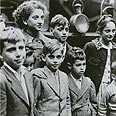She sketched the thin faces of the seven teenage boys, vowing that no one will be able to erase their identity ever again.
When the Nazi war machine finally pulled back in the spring of 1944, not many refugees remained in the Transnistria region in the Moldova area. In March of that year, all the young orphans were released from the camps and sent to the Jewish community in Bucharest, Romania.
At least seven children were adopted by the Ziegler family. Evelyn, who saw what a difficult state they were in, decided to draw their portraits.
At the foot of the drawings she wrote down comments expressing her feelings. "An 18-year-old boy from Moldova, does he deserve to suffer?" she asked. Only one portrait has a name on it – Michel Korlero.
Later on Evelyn got married and immigrated to Israel, and her work made its way to Yad Vashem. Now the drawings are looking for their owners.
Three of those sketched are believed to have been 15 to 18 years old in the spring of 1944. The girl and the two younger children were likely 10 years old. These children may have survived the horror and perhaps even immigrated to Israel.
'Systematic effort to portray brethren'
These faces are part of an exhibition which opened Monday at the Yad Vashem museum, on the eve of International Holocaust Remembrance Day, marking the 70th anniversary of the Wannsee Conference, where Nazis coordinated the "final solution" – the genocide of European Jews.
The exhibition, "Last Portrait: Painting for Posterity," presents some 200 works created by 21 Jewish artists during the Holocaust to document and commemorate their friends and acquaintances in the ghettos and camps.
Nearly 60 of the faces telling the story of the greatest disaster in the Jewish people's history have yet to be identified.
"We've conducted an extensive inquiry in a bid to find out details about these people," says exhibition curator Eliad Moreh-Rosenberg. "We hope that following the exhibition and the portraits' exposure to the wide public, we'll receive new information about the people looking at us from the portraits, who have so far remained anonymous.
“What makes this exhibition unique is the presentation of a systematic effort by Jewish artists to portray their brethren during a cataclysmic time, creating a body of work of astounding dimensions. For many of the subjects, the artist’s recording of their faces, moments before death, makes for their final portraits.”
















